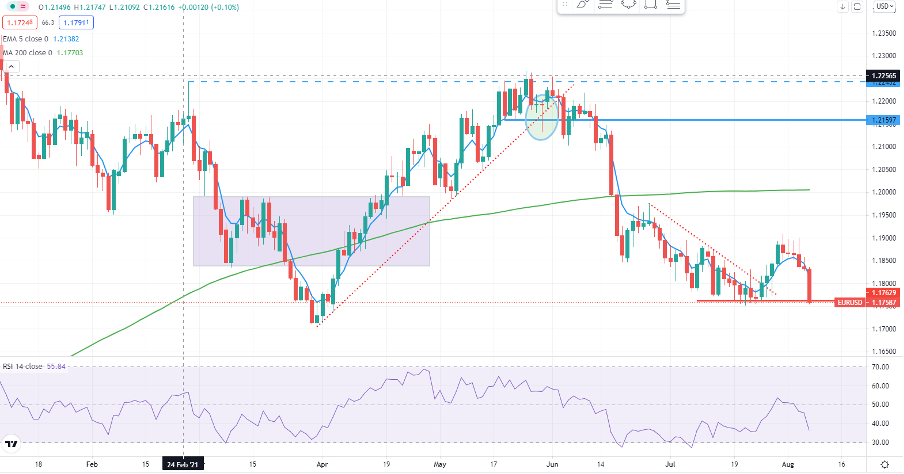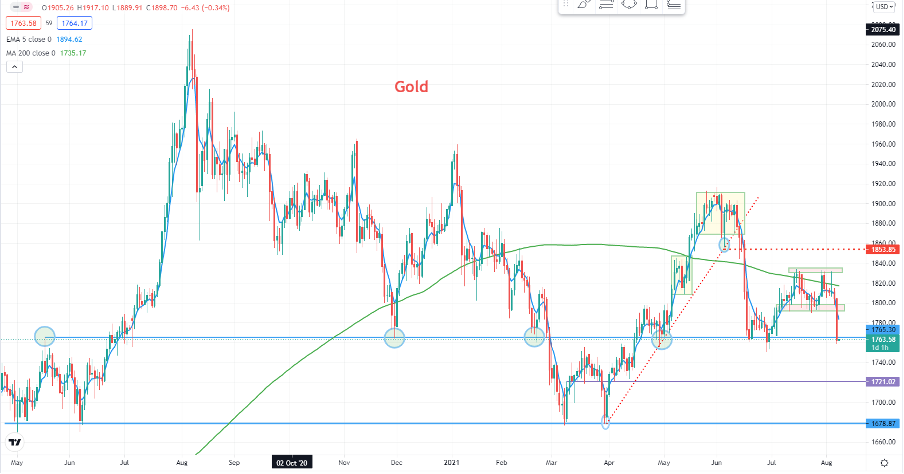The week ahead playbook - The passage of central bank tightening gets closer every day

But whether the clouds are genuinely turning darker, and risk is about to crack is yet to be seen – if the market thought this was about to play out, we certainly haven’t seen it resonate in implied volatility, with the VIX closing 2 vols lower on the week at 16.15% and bond volatility falling too. 1-month S&P 500 put volatility fell relative to calls, but here we are talking not just about the Fed tapering it asset purchases, but far more importantly we’re debating the pace of tapering and the future pace for Fed rate hikes.
It wasn’t just the Fed, after the NZ employment report it will take something incredible for the RBNZ not to hike on 18 August. The RBA are overlooking an inevitable shutdown-led contraction in Q3 GDP to continue with its tapering schedule. The BoE are not just laying out the groundwork for hikes in 2022, but disclosed where the cash rate needs to be to stop reinvesting the proceeds from maturing bonds it holds on its balance sheet and will even actively selling off its holdings when (‘if’) the BoE cash rate gets to 1.5% - ‘Quantitative Tightening’; something the Fed tried in 2018 and it didn’t work out too well!
US payrolls were a game-changer
They were hot and the Fed would be eyeing a further improvement in the next NFP print (3 Sept). What did the Fed see? – Not just the 943k headline jobs print (703k private payrolls), but positive revisions to the prior month’s numbers. They saw a 4% rise in wage pressures, an improved participation rate, a 60bp reduction in the U6 unemployment rate (to 9.2%), and nearly 1.9m jobs created in the past two months – this is progress, and the US economy no longer requires the level of support it once did.
Somewhat hawkish speeches from Fed Board of Governors Waller and Clarida last week have been validated.
EURUSD daily

(Source: Tradingview)
The USD was nicely bid on Friday, with Treasury yields moving up across the curve (10s were up 7bp to 1.2969%) and eyeing a break of the double bottom neckline at 1.31%. The DXY is eyeing a close above 93, and at the centre of this is the USD vs the EUR, where EURUSD is breaking the July lows of 1.1750. This central bank policy divergence 101, and a break here take the pair into 1.1704 (31 March low). Long USDJPY and USDCHF are working well, and if the US bond market does indeed attract a more consistent sell-off (yields higher) then being long vs the ‘funding’ currencies is a good bet.
US CPI is the marquee event risk this week
If this week’s US (July) core CPI is hotter than the 0.4% MoM consensus then the greenback should attract further buyers, driven largely by nominal and real rates moving higher – US banks should find the love, as they did on Friday - so being long the S&P Bank ETF (KRE) would be a trade to hedge a hot CPI print. The debate on the duration of ‘transitory’ inflation is still one the macro community debates fiercely, and should we get a number close to 0.5% MoM (or above), then we’d have to go back to the 1990s to see this sort of consecutive monthly advances in price pressures.
Also, keep an eye on the US JOLTS report (Tuesday 00:00 AEST), with jobs openings expected to lift to 9.27m, while the NFIB small business optimism (Tuesday 20:00 AEST) is expected to come in modestly lower than June at 102.0. I don’t expect either to compete with the market interest in the US CPI print, but they are important in their own way and add to the argument that the US labour market will remain hot in September.
XAUUSD daily

(Source: Tradingview)
Calling a low in US Treasuries has become fair game, but get your bond and rates call right and you are halfway to getting your USD call right, and with-it US banks and gold will take it its steer – perhaps the market has caught on because gold and silver were slammed, and XAUUSD is testing key horizontal support (see above) and it seems a make-or-break week for the precious metals complex.
Perhaps some of the capital in precious metals has flocked to crypto, as money chased the move, noticeably in Ethereum after the London Hard Fork, where the recent gains in crypto have been staggering – that said we’ve seen profit-takers hone in with price falling 6% (Sunday’s high) from 3190 to currently sit at 3000 – and for anyone looking solely at the RSI and seeing this above 75 and thinking of getting short on this oscillator alone - well, since 2000 if one had sold ETH when the 14-day RSI moved above 75, you’d have placed 16 short trades and seen price down 5 days later only in 7 of those occurrences – the average loss would have been 2.81x the gain – so shorting into strength has historically not offered any kind of edge.
So, watching CPI this week
Can US Treasury yields head through 1.31%, with real (inflation-adjusted) moving less negative? Can we see the Eurodollar interest rate curve steepen and price in increased hikes? If the answer is ‘yes, which I see as an increased probability, then the USD should gain this week and breakout, with second derivatives such as gold and financials reacting. The Fed, or the perception of Fed action, sit at the heart of the market this week above all else and for traders, potential opportunity could be ahead.
Related articles
The material provided here has not been prepared in accordance with legal requirements designed to promote the independence of investment research and as such is considered to be a marketing communication. Whilst it is not subject to any prohibition on dealing ahead of the dissemination of investment research we will not seek to take any advantage before providing it to our clients.
Pepperstone doesn’t represent that the material provided here is accurate, current or complete, and therefore shouldn’t be relied upon as such. The information, whether from a third party or not, isn’t to be considered as a recommendation; or an offer to buy or sell; or the solicitation of an offer to buy or sell any security, financial product or instrument; or to participate in any particular trading strategy. It does not take into account readers’ financial situation or investment objectives. We advise any readers of this content to seek their own advice. Without the approval of Pepperstone, reproduction or redistribution of this information isn’t permitted.
